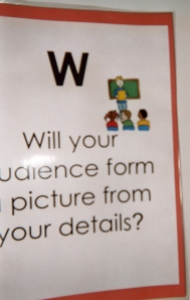Mid-Week Focus this week features a visually based approach to helping elementary school students who struggle with language arts.
You know who they are in your class. The teachers I met with yesterday to plan my upcoming week as a writer in residence with their third grade classes were quick to point out how their students struggle with language mastery. “We need you to help with sentence writing before non-fiction full story writing, they told me. “Some of our kids aren’t anywhere close to writing complete personal narratives.” they lamented.
WRITING IS LIKE PUTTING PUZZLES TOGETHER – I mentioned my “puzzle approach” to writing stories, and the teachers were enthusiastic about the concept. Maybe this approach can help your class, too. “Our students will get that,” the teachers I was meeting with mused. “Tell us more;” they wanted details…
…Why the puzzle approach works really isn’t puzzling at all. Kids love puzzles. Puzzles form pictures. When a teacher describes writing as the process of penciling in one piece at a time to construct a whole picture – a story – a report – expository writing – any kind of writing – students get the picture!
Kids can visualize a finished piece of writing when they picture it as a completed puzzle…
…the FOCUS is like the PHOTO on the cover of the puzzle box. If it’s colorful and attention-getting, it will attract.
…each sentence needs to be strong. Each sentence is an important part of the picture.
- Write with active verbs and the action brings the picture to life.
- Paint pictures with words by writing with plenty of description.
- Include dialog or testimonials that are the “voices” of the subjects in the picture.
…sentences become paragraphs. It’s important to write “transition sentences” that link one to another, like pieces of a puzzle need to fit together.
…paragraphs become complete stories, or reports, or complete opinions (Core Writing Skills). Each paragraph is a big puzzle piece. They have to be organized in a logical sequence so that the picture the puzzle forms comes together and is clear!
…the process and the results need to be satisfying! I tell students this: “If you have a good time writing your ___________ (genre), there’s a very good chance that your reader or listener will enjoy your work as well.”
Children don’t just build writing skills when they approach writing as piecing a puzzle together; they build self-confidence…
BUILD STUDENTS’ CONFIDENCE PUTTING WORD PUZZLES TOGETHER – When kids get the picture of how to write as if they were putting a puzzle together, it’s a happy moment when the puzzle is complete. Praising their efforts helps build self-confidence. Confidence is key in effective communication. Confidence shines through in the written word, as well as in the spoken word. Students who struggle with writing and reading especially benefit from confidence-boosters.
HELP STRUGGLING WRITERS – To help struggling fourth and fifth grade students master core writing concepts, one teacher I worked with recently posts eye-catching graphics on one of her classroom walls. The set features the word W-R-I-T-E. Collectively, the posters make an acrostic poem – another kind of word puzzle.
Each letter is paired with a colorful picture to reinforce the message.
W – Will your audience form a picture from your details? Graphic: a presenter in front of the first row of an audience.
R – Read the story to yourself. Read with the teacher. Graphic: a funny figure in pajamas and a sleep cap reading a book while sitting on a crescent moon.
I – Is my story inviting? Is there a capital letter at the beginning of every sentence? Graphic: a capital letter highlighted in a sample sentence.
T – THINK! Is there a clear beginning, middle and end? Graphic: a happy face with a lightbulb lit up on top.
E – Each part includes * characters * setting * problem * solution (not all stories present problems to be solved, but this is one approach to help students write well). Graphic: a piece of paper with a big check mark on it.
Look for other resources online to help struggling student writers.
Teachers who use visual aids, like the posters that form an acrostic poem, find that when they hold up the W-R-I-T-E posters one at a time and ask the students to re-tell their story, the posters serve as effective prompts to help struggling writers. Students elaborate more when they have visual cues – puzzle pieces to put together.
How many word pictures can we form? When you ask your class to consider this, as you introduce the puzzle approach to writing, invite them to close their eyes and picture this…the puzzle shelves of their favorite toy section in a favorite store. Wow! The opportunities are endless. Big puzzles, little puzzles, every one of them offering a view of the world.
Do you keep puzzles in your classroom for student use? How do you use puzzles? Please send comments; share this link; and subscribe.
Attentionology for K – 5 Teachers will be back here on Monday.
Talk with you again soon,
Barbara ♥ The Lovable Poet



